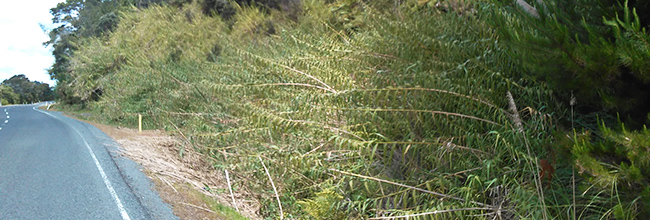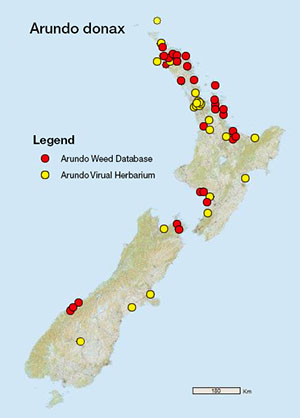Application to release giant reed gall wasp and giant reed scale insect

Giant reed
The decision can be found on EPA's website.
Background

Locations of field giant reed records (shown in red) listed in the virtual herbarium – Department of Conservation
This application will be submitted by a Regional Council, acting on behalf of the National Biocontrol Collective, a consortium of regional councils and the Department of Conservation. The Collective funds the development of weed biocontrol programmes in New Zealand. Landcare Research is the science provider and supporter for this development. Landcare Research has contracted Richard Hill & Associates to prepare the application and to manage the application process on behalf of the collective, including pre-application consultation with EPA, and with Māori and other stakeholders.
Giant reed is a clump-forming tall grass resembling bamboo. It has a dense mass of roots and can grow up to 5 m in height. Giant reed has hollow stems up to 4 cm across with bamboo-like leaves arranged alternately, clasping the stems. A plume-like flower head is produced at the top of the stem in late summer. This grass forms tall dense clumps, and is a weed of river and stream margins that can block waterways, promoting flooding. It provides a habitat for rats and possums, and poses a possible fire risk when it dries.
This species has been nominated as among 100 of the "World's Worst" invaders.
Giant reed is thought to be native to North Africa and Eurasia east of the Mediterranean but it is now found in southern Europe and most other continents including Australia.It is regarded as a major weed in California and Texas in the USA and in adjacent areas of Mexico.
Giant reed was once valued as an ornamental, and isolated infestations have been found as far south as Queenstown. However, it is mainly invasive in the north of the North Island. It is still a relatively minor weed in New Zealand, but it is spreading and it poses a severe threat to New Zealand waterways and early intervention could prevent giant reed from causing the problems that it does in North America.
- More information on giant reed: www.issg.org/database/species/ecology.asp?si=112
Identification and assessment of risks, costs and benefits
The potential risks, costs and benefits of the proposed introduction to New Zealand of Tetramesa romana and Rhizaspidiotus donacis, and the possible reduction in the abundance and vigour of giant reed will be identified by literature review and by consultation with stakeholders.
When completed, the significant effects identified (highlighted in bold) will be addressed in detail in the application. Giant reed is classed as an Unwanted Organism under the Biosecurity Act 1993. It is forbidden to sell, propagate or distribute giant reed in New Zealand. It therefore has no significant economic value. Potential benefits of biological control would be the mitigation of the adverse effects described above. These key possible adverse effects will be addressed fully in the application:
- the risk of direct damage to native grasses
- the risk of direct damage to valued ornamental grasses
- indirect effects on flora and fauna as a result of disruption of ecological relationships
Giant reed belongs to the grass family, Gramineae. There are a huge range of native and economically important species in this family. Both control agents were subjected to stringent testing before release in the USA was approved (Goolsby et al. 2009a, b). Additional testing was completed in New Zealand to ensure that the agents were safe for release here.Host range testing is complete. The host range of the both agents is restricted to Arundo species, and possibly to giant reed alone.Native and other valued plant species will not be at risk in New Zealand. Details of the testing are summarised.
These insects are expected to be host specific in New Zealand. Population densities capable of interacting significantly with other plants or animals can only be found in close proximity to the target plant. Giant reed has a limited habitat so disturbance of ecological relationships in New Zealand is not expected to be significant. These issues will be discussed in detail in the application.
Pre-application consultation with Iwi
The members of the EPA's national network (Te Herenga) will be contacted in February 2016 and invited to enter dialogue on the National Biocontrol Collective's plans to apply to EPA to introduce biological control agents against giant reed.
The message to Te Herenga will describe how the applicant intends to assess the risks, costs and benefits associated with the proposed introductions. Members will be invited to identify any issues that they would like to be addressed in the application.
The responses by Te Herenga members specifically related to the proposed introduction of giant reed will be summarised here once available:
At the request of the applicant, EPA convened a reference group from Te Herenga to meet and discuss the issues surrounding the proposed applications. The application will address the principles identified in that report.
Members of Te Herenga will be informed by EPA when each application is open for public submission, and will be able to comment on how the applicant has addressed issues raised during consultation.
Pre-application consultation with other organisations
Other organisations consulted were:
- Department of Conservation staff
- Fish and Game NZ
- Regional Councils
- Federated Farmers
- Royal Forest and Bird Protection Society of New Zealand
- Department of Conservation staff
- QEII National Trust
- NZ Landcare Trust
- Ecological Society of New Zealand.
A summary of responses will be provided here once consultation is complete
Key documents
Cited references
Goolsby JA, Moran; P. (2009). Host range of Tetramesa romana Walker (Hymenoptera: Eurytomidae), a potential biological control of giant reed, Arundo donax L. in North America. Biological Control 49: 160–168.
Goolsby JA, Moran P, Adamczyk JJ, Kirk AA, Jones WA, Marcos MA, Cortes E. (2009) Host range of the European rhizome-stem feeding scale (Rhizaspidiotus donacis (Hemiptera: Diaspididae), a candidate biological control agent for giant reed, Arundo donax (Poales: Poaceae) in North America. Biocontrol Science and Technology 19: 899–918.
Downloadable content & links
- pdf Potential beneficial and adverse effects of biological control agents for giant reed pdf File, 69 KB
- pdf Host range testing of Tetramesa romana and Rhizaspidiotus donacis pdf File, 356 KB
- pdf Summary of iwi responses to the giant reed application pdf File, 43 KB
- pdf Summary of responses to the giant reed application pdf File, 244 KB
